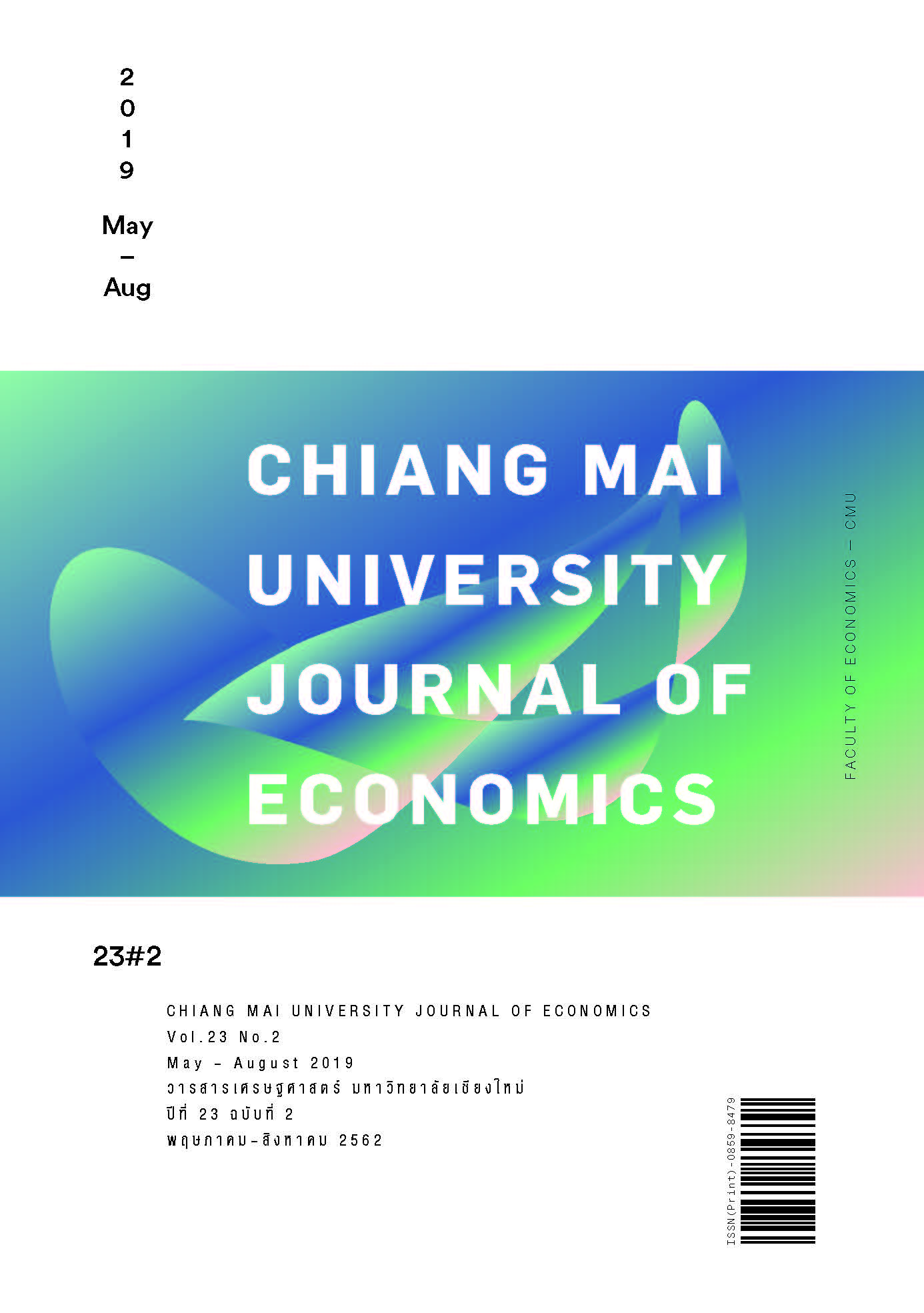การส่งผ่านผลกระทบจากความไม่แน่นอนของนโยบายเศรษฐกิจต่างประเทศต่อตลาดหลักทรัพย์ในประเทศไทย
คำสำคัญ:
ความไม่แน่นอนของนโยบายเศรษฐกิจโลก, การส่งผ่านผลกระทบระหว่างประเทศ, ตลาดหลักทรัพย์แห่งประเทศไทยบทคัดย่อ
การศึกษานี้มีวัตถุประสงค์เพื่อทดสอบการส่งผ่านผลกระทบของความเสี่ยงจากต่างประเทศในรูปของความไม่แน่นอนของนโยบายเศรษฐกิจ ที่มีต่อตลาดหลักทรัพย์แห่งประเทศไทย โดยวิเคราะห์ทั้งในระดับดัชนีตลาดหลักทรัพย์โดยรวมและดัชนีรายอุตสาหกรรม ผลการศึกษา ในช่วงก่อนปี 2553 พบว่าดัชนีความไม่แน่นอนทางนโยบายเศรษฐกิจและดัชนีความกลัว (VIX) สามารถอธิบายการส่งผ่านผลกระทบจากต่างประเทศมายังผลตอบแทนการลงทุนในไทยได้อย่างมีนัยยะสำคัญทางสถิติ อย่างไรก็ตาม ในช่วงหลังปี 2553 ชึ่งธนาคารกลางสหรัฐอเมริกาเริ่มใช้นโยบายผ่อนคลายทางการเงินเชิงปริมาณ (QE : Quantitative Easing) ทำให้ดัชนีความกลัวปรับตัวลดลงสวนทางกับดัชนีความไม่แน่นอนทางนโยบายเศรษฐกิจที่ยังคงมีค่าที่สูงตามความเสี่ยงทางการเมืองทั้งในสหรัฐฯ และสหภาพยุโรป ในช่วงนี้ ดัชนีความกลัวเป็นตัวแปรสำคัญที่ส่งผลกระทบมายังตลาดหลักทรัพย์แห่งประเทศไทยทั้งต่อผลตอบแทนและความผันผวนของตลาดหลักทรัพย์ ส่วนดัชนีความไม่แน่นอนของนโยบายเศรษฐกิจไม่ส่งผลต่อผลตอบแทนตลาดฯ อย่างมีนัยยะสำคัญในช่วงนี้ ผลการศึกษาแสดงถึงว่าดัชนีความกลัว (VIX) เป็นตัวแปรสำคัญในการจับตาการส่งผ่านผลกระทบมายังตลาดหลักทรัพย์ในประเทศไทย ส่วนดัชนีความไม่แน่นอนทางนโยบายเศรษฐกิจโลก มีบทบาทเสริมในการอธิบายการส่งผ่านผลกระทบเช่นเดียวกัน แต่จะส่งผลเสริมกับดัชนีความกลัวในช่วงที่ตัวแปรทั้งคู่ปรับตัวไปพร้อมกัน เมื่อพิจารณาผลในรายอุตสาหกรรมพบว่า ดัชนีในกลุ่มทรัพยากร มีการส่งผ่านผลกระทบจากต่างประเทศทั้งจากดัชนีความกลัวและดัชนีความไม่แน่นอนทางนโยบายเศรษฐกิจชัดเจนที่สุด
References
2. Badshah, I., Bekiros, S., Lucey, B. M., & Uddin, G. S. (2018). Asymmetric linkages among the fear index and emerging market volatility indices. Emerging Markets Review, 37, 17-31. doi:https://doi.org/10.1016/j.ememar.2018.03.002
3. Baker, S. R., Bloom, N., & Davis, S. J. (2016). Measuring Economic Policy Uncertainty. The Quarterly Journal of Economics, 131(4), 1593-1636.
4. BenSaïda, A., Litimi, H., & Abdallah, O. (2018). Volatility spillover shifts in global financial markets. Economic Modelling, 73, 343-353. doi:https://doi.org/10.1016/j.econmod.2018.04.011
5. Bollerslev, T. (1986). Generalized autoregressive conditional heteroskedasticity. Journal of Econometrics, 307-327.
6. Chancharat, S., Valadkhani, A., & Havie, C. (2007). The Influence of International Stock Makets and Macroeconomic Variables on The Thai Stock Market. Applied Econometrics and International Development, 7(1), 221-238.
7. Cho, D., & Rhee, C. (2013). Effects of Quantitative Easing on Asia: Capital Flows and Financial Markets. Econstor, 350, 1-21.
8. Christou, C., Cunado, J., Gupta, R., & Hassapis, C. (2017). Economic policy uncertainty and stock market returns in PacificRim countries: Evidence based on a Bayesian panel VAR model. Journal of Multinational Financial Management, 40, 92-102. doi:https://doi.org/10.1016/j.mulfin.2017.03.001
9. Diebold, F. X., & Yilmaz, K. (2008). Measuring Financial Asset Return and Volatility Spillovers, With Application to Global Equity Markets. NBER Working Paper(1-18), February 2008.
10. Ishfaq, M., Qiong, Z. B., & Rehman, A. u. (2018). Global Volatility Spillover in Asian Financial Markets. Mediterranean Journal of Social Sciences, 9(2), 109-116.
11. Jaiswal-Dale, A. (2009). Transmission of Shocks from Cross-Listed Markets to the Return and Volatility of Domestic Stocks. Finance Faculty Publications, 11.
12. Janrattanagul, J. (2009). The Effect of Change in Macroeconomic Data on Thailand Stock Market Returns. Xiamen University,
13. Kumar, D. (2014). Return and volatility transmission between gold and stock sectors: Application of portfolio management and hedging effectiveness. IIMB Management Review, 26(1), 5-16.
14. Liow, K. H., Liao, W.-C., & Huang, Y. (2018). Dynamics of international spillovers and interaction: Evidence from financial market stress and economic policy uncertainty. Economic Modelling, 68, 96-116.
15. Liu, Z., Ye, Y., Ma, F., & Liu, J. (2017). Can economic policy uncertainty help to forecast the volatility: A multifractal perspective. Physica A: Statistical Mechanics and its Applications, 482, 181-188.
16. Pástor, L., & Veronesi, P. (2012). Uncertainty about Government Policy and Stock Prices. The Journal of Finance, 67(4), 1219 - 1264.
17. Pongsakorn, S. (2010). Measuring Return and Volatility Spillovers in Global Financial Markets. (Bachelor' Thesis), Chulalongkorn University,
18. Raza, N., Jawad Hussain Shahzad, S., Tiwari, A. K., & Shahbaz, M. (2016). Asymmetric impact of gold, oil prices and their volatilities on stock prices of emerging markets. Resources Policy, 49, 290-301.
19. Smales, L. A. (2016). Time-varying relationship of news sentiment, implied volatility and stock returns. Applied Economics, 48:50, 4942-4960.
20. Tang, P. (2017). The Relationship between Gold Price, Euro, US Dollar, Oil Price and Stock Market. Case the European Union. University of Applied Sciences,
21. Tsai, I. C. (2017). The source of global stock market risk: A viewpoint of economic policy uncertainty. Economic Modelling, 60, 122-131.
22. Tursoy, T., & Faisal, F. (2018). The impact of gold and crude oil prices on stock market in Turkey: Empirical evidences from ARDL bounds test and combined cointegration. Resources Policy, 55, 49-54. doi:https://doi.org/10.1016/j.resourpol.2017.10.014
23. Wai, P. S., Ismail, T. M., & Kun, S. S. (2013). Commodity Price Effect on Stock Market: A Markov Switching Vector Autoregressive Approach. International Journal of Scientific & Engineering Research, 4(5), 19-24.
24. Whaley, R. E. (2000). The Investor Fear Gauge. The Journal of Portfolio Management, 26(3), 12-17.
25. Yu, H., Fang, L., & Sun, B. (2018). The role of global economic policy uncertainty in long-run volatilities and correlations of U.S. industry-level stock returns and crude oil. PLoS ONE, 13(2), 1-17.
26. Yu, H., Fang, L., & Sun, W. (2018). Forecasting performance of global economic policy uncertainty for volatility of Chinese stock market. Physica A: Statistical Mechanics and its Applications, 505, 931-940. doi:https://doi.org/10.1016/j.physa.2018.03.083
27. ศินี ตั้งทองหยก. (2553). ความสัมพันธ์ระหว่างเศรษฐกิจมหภาค อัตราผลตอบแทนทองคำ และอัตราผลตอบแทนหลักทรัพย์ในตลาดทุน. (การค้นคว้าอิสระปริญญาวิทยาศาสตร์มหาบัณฑิต (การบริหารการเงิน) ), มหาวิทยาลัยธรรมศาสตร์,
Downloads
เผยแพร่แล้ว
ฉบับ
บท
License
All opinions and contents in the CMJE are the responsibility of the author(s). Chiang Mai University Journal of Economics reserves the copyright for all published materials. Papers may not be reproduced in any form without the written permission from Chiang Mai University Journal of Economics.
ข้อคิดเห็นที่ปรากฏและแสดงในเนื้อหาบทความต่างๆในวารสารเศรษฐศาสตร์มหาวิทยาลัยเชียงใหม่ ถือเป็นความเห็นและความรับผิดชอบโดยตรงของผู้เขียนบทความนั้นๆ มิใช่เป็นความเห็นและความรับผิดชอบใดๆของวารสารเศรษฐศาสตร์ มหาวิทยาลัยเชียงใหม่
บทความ เนื้อหา และข้อมูล ฯลฯ ในวารสารเศรษฐศาสตร์มหาวิทยาลัยเชียงใหม่ ถือเป็นลิขสิทธิ์เฉพาะของคณะเศรษฐศาสตร์มหาวิทยาลัยเชียงใหม่ หากบุคคลหรือหน่วยงานใดต้องการนำทั้งหมดหรือส่วนหนึ่งส่วนใดไปเผยแพร่ต่อหรือเพื่อกระทำการใดๆ จะต้องได้รับอนุญาตเป็นลายลักษณ์อักษร จากวารสารเศรษฐศาสตร์ มหาวิทยาลัยเชียงใหม่





